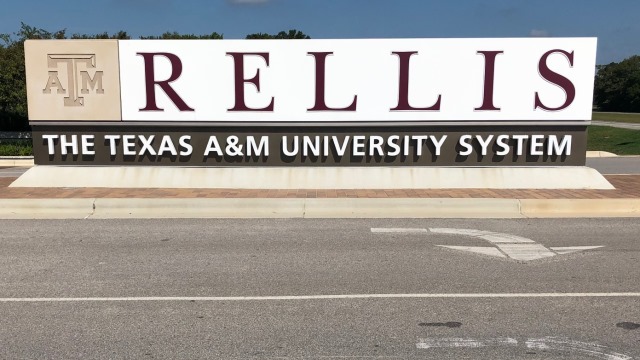
Thursday’s meeting (November 7) Texas A&M system board of regents meeting included approving five items associated with the RELLIS campus.
The board increased the budget for the new Texas A&M semiconductor institute to $189 million dollars and set aside $19 million for pre-construction services.
Click HERE to read and download background information about the semiconductor institute.
The regents also approved moving ahead with building a hypersonic wind tunnel. Construction starts in December on the $10 million dollar project, which the system says will become the largest academic facility of its kind in the country by providing large-scale aerodynamic testing in the range of Mach 5 to 9. The single-story facility will complement research at the adjacent Ballistics Aero-optics and Materials (BAM) Range and the Detonation Research Test Facility
Chancellor John Sharp says the hypersonic wind tunnel will be used by a company that wants to build an aircraft that can get from Houston to Tokyo in one hour and 25 minutes.
Click below to hear John Sharp’s comments about the purpose of the RELLIS campus hypersonic wind tunnel.
Audio Player
Click HERE to read and download background information about the hypersonic wind tunnel.
The board approved creating a $25 million dollar training complex operated by TEEX…the Texas A&M engineering and extension service. The 86-acre site will allow construction of an urban simulation grid, drive track, skills pad, props building and classrooms. The site also will eventually be the location for a future headquarters.
Click HERE to read and download background information about the TEEX training complex.
The regents agreed to purchase 77 acres of land that will expand the RELLIS campus to the west. The purchase price was not disclosed.
And the regents agreed to apply to the federal nuclear regulatory commission to allow the construction of small nuclear reactors at RELLIS.
News release from the Texas A&M system about applying to locate nuclear reactors at RELLIS:
Nuclear power companies and technology giants now can look to The Texas A&M University System for much sought-after land to test the latest nuclear reactors.
Several agreements have been made between reactor manufacturers and technology behemoths to provide the power that is necessary for modern computing, but few suitable locations have been identified…until now.
Today, officials with the Texas A&M System took the first official step to provide the sites that nuclear companies desperately need. Also notably, the Texas A&M System will be the only higher education institution with a commercial reactor site license.
The Texas A&M University System Board of Regents agreed to notify regulators at the federal Nuclear Regulatory Commission today that it has potential sites available at Texas A&M-RELLIS in Bryan for multiple companies to test and construct the next generation of nuclear reactors. The “test bed” is expected to lead to energy advancements that could provide power to data centers for artificial intelligence and other power-hungry ventures.
John Sharp, chancellor of the Texas A&M System, said no other entity in the U.S. is further along than the Texas A&M System to provide a location and human resources to get small, modular nuclear reactors online. The test bed for the reactors will support multiple reactors from various companies, Sharp added. The reactors at the site also could put additional power into the state’s energy grid at a time of high demand.
“The Texas A&M System is the missing piece of the puzzle,” Sharp said. “States on the west coast and east coast would never attempt what we are doing. Under the leadership of Gov. Greg Abbott, only Texans – particularly those at the Texas A&M System – have the courage to take on such a weighty and ambitious responsibility.”
The submission of the letter of intent to the regulators marks the beginning of a licensing process for the A&M System. Reactor companies will benefit from the A&M System taking on the licensing burden. The result will be a shorter path to getting their reactors up and running.
The type of reactors that could be tested at Texas A&M-RELLIS are often classified as “small modular reactors,” or SMRs. They have a footprint that is a fraction of the size of a traditional reactor, and they can produce up to 300MW(e) per unit, compared with more than 700MW(e) per unit with traditional reactors.
The Texas A&M System recently concluded the process of gathering proposals from nuclear reactor companies that hope to construct reactors at Texas A&M-RELLIS. Some of the businesses that submitted proposals already have announced partnerships with large technology companies to power their ventures with nuclear energy. Negotiations are expected to begin soon. Also, there might be additional opportunities for organizations to take advantage of the A&M System’s site for nuclear testing and the manufacturing of modular reactors.
After negotiations are complete, the A&M System will announce which companies will conduct testing and other work at Texas A&M-RELLIS.
The Texas A&M System, along with Texas A&M University, is uniquely qualified to take on a venture as ambitious as building, testing and running nuclear reactors. The System’s flagship campus in College Station – just a few miles from the testbed – employs dozens of professors and researchers with nuclear expertise. Plus, Texas A&M University is home to the largest nuclear engineering department of any university in the country. The A&M System also helps manage the Los Alamos National Laboratory and Pantex, the nation’s primary plant for the assembly and disassembly of nuclear weapons.
Sharp said: “From the people, to the land, to the enthusiasm to innovate, the Texas A&M System has everything we need to help the country meet its clean energy needs.”
